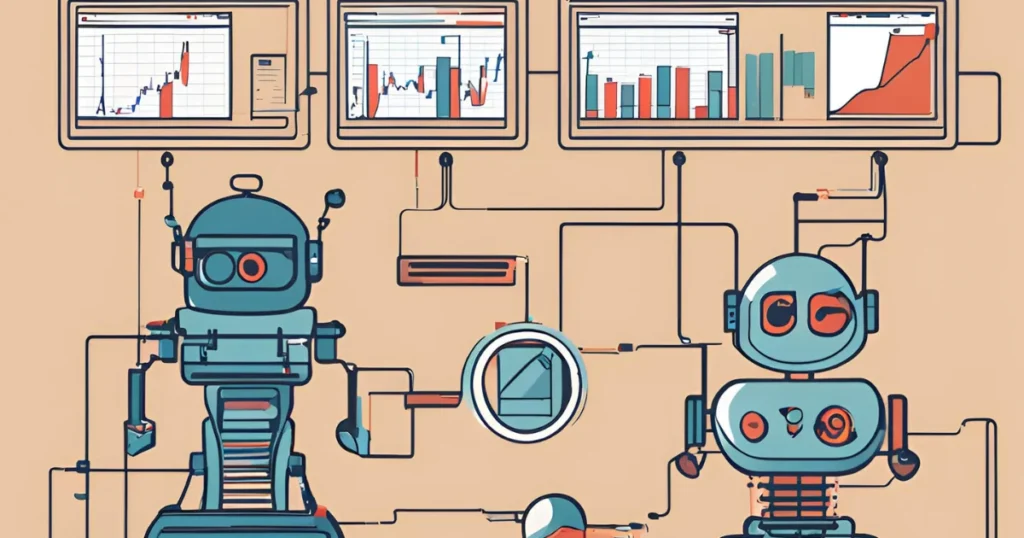Creating a trading bot with ChatGPT can revolutionize your trading experience by automating strategies and enhancing decision-making processes.
This article will guide you through the essential steps, ensuring you understand how to harness the power of AI in your trading endeavors effectively.
Understanding Trading Bots
What is a Trading Bot?
A trading bot is a software program that uses algorithms to analyze market conditions and execute trades on behalf of the trader. Bots can operate 24/7, removing the emotional biases and fatigue that can affect human traders.
Types of Trading Strategies:
There are various strategies you can implement using a trading bot, including:
- Trend Following: Buying when prices are rising and selling when they are falling.
- Momentum Trading: Taking advantage of price momentum in a particular direction.
- Mean Reversion: Betting that prices will revert to their historical average.
- Arbitrage: Capitalizing on price discrepancies across different markets.
Selecting the right strategy is crucial, as different approaches may yield varying results depending on market conditions.
Setting Up Your Environment
Prerequisites
Before diving into development, ensure you have:
- Basic programming skills, preferably in Python.
- An OpenAI API key to access ChatGPT’s capabilities.
- A trading account on platforms like Alpaca or Binance to execute your trades.
Tools and Libraries
You’ll need several libraries to facilitate data analysis and trading:
- Pandas: For data manipulation.
- NumPy: For numerical operations.
- ccxt: For accessing cryptocurrency exchanges.
Building the Trading Bot
Step 1: Define Your Trading Goals
Start by clarifying what you want to achieve. Set clear objectives, such as target profit levels and acceptable risk thresholds.
Step 2: Data Acquisition
Use APIs like Alpha Vantage or Yahoo Finance to gather historical and real-time data necessary for analysis. Here’s a sample Python code snippet to fetch data:
Python Code:-
import pandas as PD
import finance as if
# Fetch historical data for a specific stock
data = of.download("AAPL", start="2023-01-01", end="2023-10-01")
print(data.head())Step 3: Data Preprocessing
Clean and structure the data to make it ready for analysis. This might include handling missing values and normalizing data.
Step 4: Strategy Development
Utilize ChatGPT to define trading rules. For example, you might ask ChatGPT:
“Can you help me create a trading strategy based on moving averages?”
ChatGPT can assist in formulating specific conditions for entering and exiting trades, including setting stop-loss orders.
Step 5: Integration of ChatGPT
You can leverage ChatGPT to perform market analysis and generate trading signals. An example interaction might look like:
“What are the current market trends for Bitcoin?”
Step 6: Trade Execution
Implement code to execute trades based on the signals generated. Here’s a basic example of how to place an order using the Alpaca API:
Python code
import alpaca_trade_api as trade API
# Initialize API
API = trade API.REST('APCA_API_KEY_ID', 'APCA_API_SECRET_KEY', base_url='https://paper-api.alpaca.markets')
# Place a market order
API.submit_order(
symbol='AAPL',
qty=1,
side='buy',
type='market',
time_in_force='gtc'
)Testing and Optimization

Backtesting and Forward Testing
Before deploying your bot, it’s vital to backtest its performance against historical data. This will help you identify weaknesses in your strategy and make necessary adjustments.
Optimization Tips
Regularly evaluate and optimize your trading bot’s performance by adjusting strategies based on market conditions and backtest results.
Common Challenges and Solutions
Trading bots can face several challenges, such as:
- Market Volatility: Sudden market changes can impact performance. Use robust risk management strategies.
- Overfitting: Avoid creating overly complex models that perform well on historical data but fail in live markets.

To mitigate these issues, ensure that your bot has a well-defined risk management strategy and conducts regular performance reviews.
Real-World Examples and Case Studies
Several traders have successfully utilized ChatGPT to enhance their trading bots. For instance, bots that implement adaptive learning mechanisms—adjusting their strategies based on market feedback—have shown promising results. Analyzing these successes can provide valuable insights for your trading bot.
Future Trends in AI and Trading Bots
The future of AI in trading is bright, with continuous advancements in machine learning algorithms and data analysis techniques. As these technologies evolve, traders must remain adaptable, harnessing new tools to enhance their trading strategies.
Conclusion
Creating a trading bot with ChatGPT opens up a world of possibilities for traders. By automating strategies and utilizing AI for market analysis, you can improve your trading efficiency and outcomes. Start experimenting with ChatGPT today, and watch your trading evolve!






